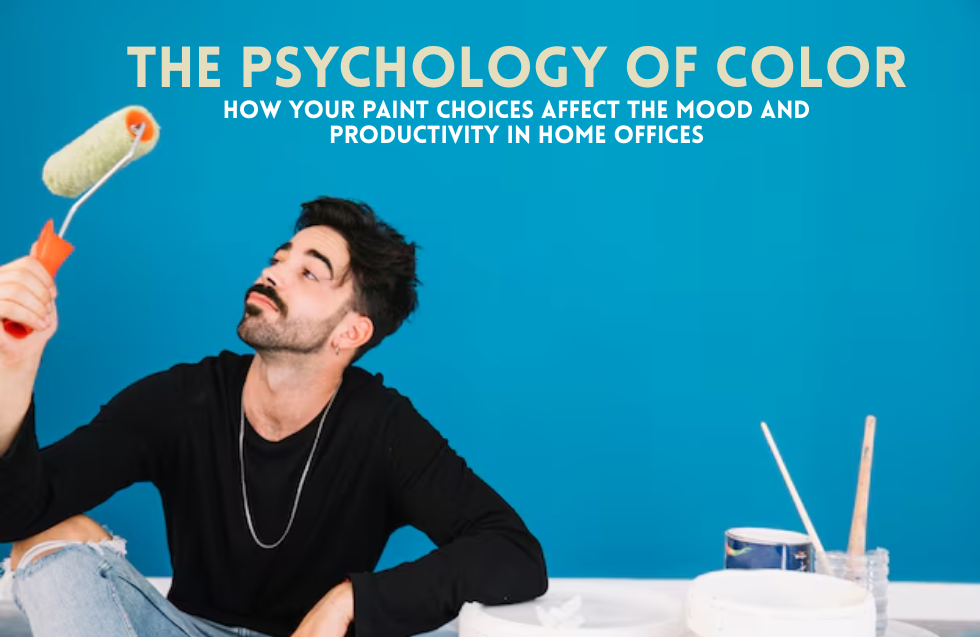The colours that surround us do more than simply please the eye—they actively influence our mental state, emotional wellbeing, and even our productivity levels. As more people continue to work from home, the impact of wall colours in home offices has become increasingly significant. The right paint choices can create an environment that enhances focus, reduces stress, and boosts creative thinking.
Professional painters understand the nuanced psychology behind colour selection far better than the average homeowner. A skilled Toronto painter brings years of experience and training to the table, offering insights that go beyond aesthetic preferences. These experts can analyse a space’s specific lighting conditions, room dimensions, and functional requirements to recommend colour schemes that will support the occupant’s well-being and professional goals.
Selecting appropriate colours requires consideration of numerous factors that many homeowners might overlook. The direction a room faces, the amount of natural light it receives throughout the day, and even the type of work conducted in the space all influence which colours will perform best. This complex interplay of elements makes professional consultation invaluable for creating truly effective home office environments.
How Colours Affect Mood and Performance
Blues for Focus and Productivity
Blue tones are widely recognised for their calming effect on the mind, helping to reduce anxiety and promote concentration. Lighter blues can make a space feel open and peaceful, while deeper navy tones add sophistication and depth. Studies have shown that blue environments may help people process information more efficiently, making this an excellent choice for home offices where analytical thinking is required.
When incorporated thoughtfully, blue can create a stable, trustworthy atmosphere that facilitates clear thinking. Professional painters can recommend specific blue shades that will work with existing furniture and accessories while maximising these psychological benefits. They might suggest using blue as an accent wall to prevent the room from feeling too cold or clinical.
Greens for Balance and Creativity
Green sits at the centre of the colour spectrum and requires minimal eye adjustment, making it naturally restful for human vision. This colour evokes the refreshing qualities of nature, potentially reducing eye strain during long work sessions. For those seeking a balance between calm focus and creative thinking, various shades of green offer an excellent compromise.
Professional painters often recommend the color green for people who need to shift between different types of mental tasks throughout the day. Sage greens and soft olive tones can foster a sense of renewal and harmony in a home office. These professionals understand how to integrate these colours without making the space feel overly casual or detracting from its primary function.
Yellows for Optimism and Energy
Yellow stimulates mental activity and can promote optimism and confidence, qualities that might benefit professionals who need to maintain high energy levels. However, too much bright yellow can increase anxiety and cause visual fatigue. This delicate balance highlights why professional colour selection matters so tremendously.
Experienced painters know how to incorporate yellow judiciously, perhaps suggesting a warm buttery tone rather than a vibrant primary yellow, or recommending it for accent pieces rather than entire walls. They understand that the psychological effects of yellow vary significantly depending on its intensity and the specific undertones present in the chosen shade.
The Impact of Colour Temperature on Productivity
Warm Colours for Creative Work
Reds, oranges, and certain yellows fall into the warm colour category and can stimulate conversation, emotional responses, and creative thinking. These colours might benefit writers, designers, and others who rely heavily on innovative thought processes. However, these stimulating colours must be used carefully to avoid creating distracting or overwhelming environments.
Professional painters have extensive knowledge about which specific warm tones work best in different settings. They understand that a soft terracotta might enhance creative thinking without the potentially aggressive associations of a bright red. This nuanced understanding comes from years of observing how different colours perform in various environments.
Cool Colours for Analytical Tasks
Beyond blue, colours like certain greys and purples fall into the cool spectrum and may enhance logical thinking and precision. Financial professionals, programmers, and others who perform detail-oriented work often benefit from cooler colour schemes. These colours recede visually, creating a sense of spaciousness that can prevent feelings of confinement during long work sessions.
Painters with professional training can explain how specific cool tones interact with artificial lighting—an important consideration for spaces used during evening hours. They might recommend particular undertones that will maintain their intended psychological effect regardless of whether the room is lit naturally or artificially.
Professional Application Makes the Difference
Proper Preparation and Techniques
Even the most psychologically beneficial colour can fail to achieve its intended effect if poorly applied. Professional painters use techniques that ensure even coverage, proper texture, and accurate colour representation. Their expertise extends to preparing surfaces properly, which affects how light interacts with the finished paint and, consequently, how the colour is perceived.
The difference between amateur and professional application becomes particularly noticeable in home offices, where people spend extended periods scrutinising their surroundings. Uneven application or improper preparation can create distracting visual elements that undermine the psychological benefits of even the most carefully selected colours.
Complementary Finishes for Functional Spaces
Beyond colour selection, professional painters advise on appropriate finishes for different areas within the home office. A slightly reflective finish might enhance natural light in darker spaces, while matte finishes reduce glare on walls behind computer screens. These considerations directly impact comfort during extended work sessions.
The practical knowledge of finish properties represents another area where professional expertise proves invaluable. Professionals understand which finishes stand up to cleaning (important for high-use spaces) while still delivering the desired visual and psychological effects. This practical knowledge complements their understanding of colour psychology.
Personalised Colour Consultation Process
Assessing Work Styles and Preferences
Professional painters typically begin their consultation by discussing the type of work performed in the space and the homeowner’s personal responses to different colours. Someone who finds blue energising rather than calming might receive different recommendations than what general colour psychology would suggest. This personalised approach recognises individual variation in colour response.
Through thoughtful conversation and assessment, painters develop tailored recommendations that acknowledge both universal colour principles and individual preferences. This balanced approach leads to more successful outcomes than either strictly following colour psychology rules or making selections based solely on personal preference without consideration of psychological effects.
Testing Colours in Real Conditions
Rather than relying solely on small paint chips viewed under store lighting, professionals often recommend testing larger swatches on actual walls. They understand how colours appear differently throughout the day as natural light changes, and can anticipate these variations based on room orientation and window placement. This testing process helps avoid costly mistakes and disappointment.
Professional painters often maintain relationships with clients, allowing for adjustments if the initial colour selections don’t deliver the expected psychological benefits after living with them. This ongoing support ensures that home office environments truly support productivity and wellbeing rather than detracting from it.
Creating a Cohesive Colour Strategy
For home offices that connect visually to other spaces, professional painters develop cohesive colour strategies that maintain the psychological benefits of the office colours while creating pleasing transitions to adjacent areas. This holistic approach ensures that the home office feels purposeful but not disconnected from the rest of the living environment.
Professional colour strategy might include selecting complementary accent colours that create visual interest without compromising the primary psychological effects of the main wall colours. This balanced approach prevents the monotony that can occur with single-colour spaces while maintaining the intended mood and functionality.
Conclusion: Expert Guidance for Optimal Results
The psychology of colour represents just one area where professional painters offer value beyond simple application services. Their knowledge of how different hues affect mood, productivity, and overall wellbeing can transform a home office from merely functional to genuinely supportive of professional success. For those serious about creating an optimal work environment, consulting with experienced painters who understand these principles is an investment in both property value and personal wellbeing. Book a colour consultation today to discover how the right paint choices could enhance focus, creativity, and satisfaction in your home workspace.












